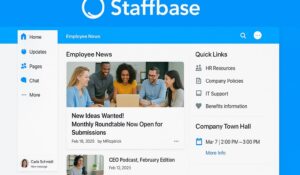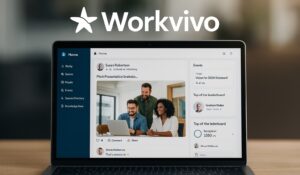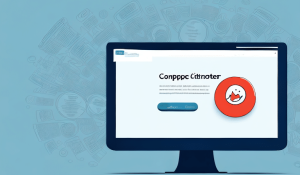Rolling out a new company intranet is one of the most important digital workplace projects a company can take on. When we help organizations launch company intranet solutions, we often see that small improvements in structure and communication can dramatically boost long‑term engagement. a company can take on. Yet, many intranets fail to deliver on their promise—either because usability is poor, adoption lags, or employees don’t see the value. Whether you’re planning your company intranet rollout for the first time or looking to fix issues with your current platform, the key is to focus on usability, engagement, and continuous improvement.
Research from Gallup shows only 31% of U.S. employees were engaged in 2024, underscoring the need for tools that connect people with purpose. McKinsey also found that using social and collaborative technologies can raise productivity by 20–25%—proof that a well-implemented intranet can make a measurable impact. The right corporate intranet software ensures these benefits are realized at scale.
👉 For a complete overview of features, types, and benefits, see our intranet software guide.
What are company intranets, and why do employees love them?
When we work with organizations evaluating company intranet solutions, one thing becomes obvious quickly: employees love intranets that feel intuitive, helpful, and designed for how they actually work.
A company intranet is a secure, centralized digital hub where employees access information, communicate, collaborate, and stay connected to workplace resources. Whether you’re an enterprise or exploring an intranet for small business, the purpose is the same—bring everything employees need into one unified place. where employees access information, communicate, collaborate, and stay connected to workplace resources. Unlike a public website or scattered internal tools, a company intranet brings everything together into one unified experience—documents, updates, workflows, social features, and day‑to‑day essentials.
Employees love well‑designed company intranets because they:
- Save time by giving quick access to policies, tools, and information.
- Reduce confusion with one trusted source of truth instead of emails, chats, and multiple apps.
- Create community with social feeds, recognition walls, and peer‑to‑peer interaction.
- Support everyone—deskless workers, hybrid teams, and office staff—with mobile‑first access.
- Improve productivity thanks to AI search, automated digests, and integrated workflows.
- Empower employees to self‑serve tasks like updating profiles, submitting forms, or finding SOPs.
In short, employees love company intranets not because they are “nice to have,” but because a modern intranet removes friction from everyday work, strengthens culture, and helps people feel more connected and informed every day.
What content should be on a company intranet?
If we want our company intranet to succeed, the content must be useful, easy to find, and relevant across teams. Below is a clean, easy‑to‑scan table summarizing the 10 essential content categories every company intranet should include.
Below is a clean, easy‑to‑scan table summarizing the 10 essential content categories every company intranet should include, along with examples of what belongs in each.
| Content Type | What It Includes |
|---|---|
| 1. Company News & Announcements | CEO updates, leadership messages, policy changes, crisis communications, department announcements, benefits reminders |
| 2. Documents, Policies & Knowledge Base | Employee handbook, SOPs, compliance documents, safety guidelines, training guides, version‑controlled files |
| 3. Tools, Apps & Quick Links | Payroll & HR systems, IT helpdesk, scheduling tools, LMS platforms, links to SharePoint/Google Drive/OneDrive |
| 4. Employee Directory & Org Structure | Employee profiles, photos, titles, departments, expertise, searchable skills directory, org charts |
| 5. Social & Engagement Features | Social feed, peer recognition, kudos, celebrations, community groups (DEI, wellness), surveys, polls |
| 6. Department or Location Hubs | HR hub, IT hub, operations hub for frontline teams, marketing/sales hubs with assets and updates |
| 7. Onboarding & New Hire Resources | Welcome videos, first‑week checklist, intro training, company values, buddy program info |
| 8. AI‑Driven Content & Personalized Dashboards | Personalized news, role‑based updates, AI digests, recommendations, smart notifications |
| 9. Forms, Workflows & Self‑Service Tools | PTO requests, expenses, IT tickets, maintenance requests, idea submissions, digital forms |
| 10. Multimedia & Branding Assets | Internal videos, branded messaging, logos, templates, campaign materials |
A great intranet doesn’t just store content—it organizes it intelligently, keeps it up to date, and ensures every employee (including frontline and mobile‑only workers) can access what they need instantly. When information is easy to find and participation is encouraged, the intranet becomes a true digital homebase.
Top Company Intranet Software Rollout Mistakes to Avoid
When organizations—especially those evaluating company intranet solutions or upgrading an intranet for small business—run into problems, the root cause is almost always weak planning or lack of governance.
While companies invest heavily in company intranet software, many still fall short. Studies suggest that up to 40% of intranets fail to achieve sustained adoption within the first year, often due to lack of planning, poor usability, or weak governance. A Deloitte study highlighted that organizations can spend millions on corporate intranet software projects but fail to meet engagement goals if employees don’t see daily value.
Common mistakes include:
- Launching without a clear communication plan.
- Overloading the intranet with content but lacking structure.
- Ignoring frontline or non-desk workers in the rollout.
- Failing to measure and optimize after launch.
Avoiding these pitfalls ensures your investment in business intranet platforms translates into measurable ROI and stronger employee engagement. Research from Prescient Digital Media found that the average intranet project costs around $40,000–$250,000 to launch, yet many organizations still struggle with low adoption. Without a clear rollout strategy, companies risk spending heavily but failing to achieve engagement.
📊 Visual: Intranet Investment vs. Adoption Outcomes
| Intranet Investment Common Outcome | |
|---|---|
| $40k–$250k (average launch cost) | Low adoption if usability and engagement are ignored |
| $1M+ (large enterprise projects) | Often fail to deliver ROI without clear rollout planning |
| Well-planned rollout with engagement strategy | Higher adoption, measurable ROI, stronger culture |
Tip 1 – Improve Usability with Clear Navigation and Design in Your Company Intranet Software
When you implement or optimize company intranet solutions, usability is the first place to start. with Clear Navigation and Design in Your Company Intranet Software
One of the main reasons intranets fail is poor usability. If employees can’t find what they need within seconds, adoption plummets. Simplify the navigation with:
- Clear menu structures aligned to employee needs.
- Mobile-first access for frontline and hybrid workers.
- Search optimization so documents and policies are instantly findable.
- Modern UX design that feels as intuitive as consumer apps.
📊 Nielsen Norman Group notes in its Intranet Design Annual 2024 that usability correlates strongly with productivity and employee satisfaction.
👉 Explore how intranet apps improve mobile-first usability and ensure your company intranet is accessible anywhere.
Tip 2 – Personalize Content for Better Engagement with Corporate Intranet Software
Relevance drives adoption. Employees engage more when they see content tailored to their role, department, or location. Corporate intranet software should provide:
- Role-based dashboards – HR sees HR content, frontline staff see shift updates.
- AI-driven personalization – deliver targeted news, alerts, and resources.
- Multilingual options – support diverse global teams with multilingual intranet software.
📊 Deloitte reports that companies using personalized digital tools see 40% higher intranet adoption rates compared to generic platforms.
👉 Learn how personalization comes built-in with the HubEngage employee intranet platform.
Tip 3 – Integrate Workplace Tools and Apps into Your Business Intranet Platforms
Employees don’t want another silo—they want an intranet that brings everything together. By integrating HRIS, payroll, scheduling, Microsoft Teams, Slack, and other tools, your business intranet platform becomes the single source of truth.
Benefits include:
- Fewer logins across multiple systems.
- Consolidated communication channels.
- Reduced IT overhead and cost savings.
📊 Forrester found in its Total Economic Impact study that organizations saved an average of $1.2M annually by consolidating communications and knowledge management.
👉 Compare flexible options in our cloud intranet guide.
Tip 4 – Encourage Employee Interaction and Recognition in Your Company Intranet Software
If you want high adoption, your company intranet must feel like a place where employees connect—not just consume information.
A static intranet doesn’t engage. Employees adopt platforms when they feel connected. Modern intranet for companies should feature:
- Social feeds where employees can post, like, and comment.
- Recognition walls to celebrate milestones and achievements.
Recognition tools make employees feel valued, boosting retention and morale.
👉 See how social intranet platforms drive employee connection.
💡 Case Study: A healthcare provider used recognition walls on their intranet to celebrate everyday heroes. Within 6 months, employee engagement survey scores improved by 18%.
Tip 5 – Use Gamification in Corporate Intranet Software to Drive Adoption
Gamification taps into natural motivation and creates fun, sticky experiences that keep employees coming back.
- Points systems for completing training or contributing ideas.
- Leaderboards to recognize top contributors.
- Badges and rewards to celebrate milestones.
Rather than focusing on arbitrary numbers, use gamification to reinforce company values and drive meaningful behaviors.
👉 HubEngage offers built-in gamification features that unify recognition, engagement, and productivity.
💡 Try This: Award points for knowledge base contributions and highlight leaders in a monthly “Intranet Champions” leaderboard.
Tip 6 – Leverage AI for Smarter Company Intranet Software Experiences
Artificial Intelligence is reshaping intranets. AI can:
- Create better content with automated summaries, digests, and suggested posts.
- Enable AI search so employees instantly find policies, SOPs, or colleagues.
- Personalize content by role, location, or engagement level.
- Provide AI chatbots that answer questions, guide onboarding, or assist with HR tasks.
📊 McKinsey reports that AI-powered communication and collaboration tools deliver 20–30% productivity gains.
👉 Learn more about AI-powered workplaces and how they’re transforming employee engagement.
💡 Try This: Use AI to auto-generate a weekly intranet digest email for frontline staff with top updates in under 150 words.
Tip 7 – Track Metrics and Continuously Optimize Your Corporate Intranet Software
Whether you’re an enterprise or building an intranet for small business, ongoing measurement ensures your company intranet stays relevant and valuable.
Your intranet is never “done.” It requires ongoing optimization. By tracking:
- Engagement metrics like logins, page views, and recognition activity.
- Survey results on usability and content relevance.
- Content performance to see what resonates with employees.
- Search success rate to ensure employees can quickly find information.
| KPI Target Tooling Owner | |||
|---|---|---|---|
| Monthly Active Users (MAU) | +20% in 90 days | Intranet analytics | IC/IT |
| Search success rate | >80% | AI Search logs | IT |
| Content CTR | +15% | Analytics/UTMs | Comms |
| Recognition posts/week | +25% | Social module | HR/IC |
| Time-to-find policy | <30s | UX tests | IT |
👉 For evaluation frameworks, see our intranet providers guide and intranet security guide. Learn how AI intranet search can improve findability and efficiency.
Company Intranet Examples
Here are company intranet examples that showcase real‑world designs and use cases. These examples help organizations—large and small—visualize what’s possible when a company intranet is done right.
Here are 7 strong company intranet examples that showcase what great design, content structure, and employee engagement can look like. These examples highlight different industries, use cases, and visual styles so you can see how flexible and powerful a modern intranet can be.
1. Employee Engagement Hub
A company‑wide home page featuring real‑time news, personalized alerts, social feeds, and recognition shoutouts. Ideal for organizations focusing on culture and transparency.
2. Frontline Operations Intranet
Designed for retail, hospitality, and manufacturing teams. Mobile‑first layouts, shift‑based updates, quick forms, SOP access, and multilingual support.
3. HR & People Experience Portal
Central hub for onboarding, benefits, forms, policies, PTO, and employee resources—making self‑service easy and reducing HR workload.
4. IT Support & Helpdesk Intranet
Ticket submissions, FAQ libraries, troubleshooting guides, asset lists, and AI‑powered search to minimize support requests.
5. Sales & Marketing Enablement Hub
Campaign assets, pitch decks, brand guidelines, competitive intelligence, and performance dashboards—all updated in real time.
6. Leadership Communication Portal
CEO messages, town hall archives, video updates, strategic priorities, and KPI dashboards to keep everyone aligned.
7. Learning & Development Intranet
Training modules, certification tracking, learning paths, career development resources, and AI‑recommended courses.
These examples illustrate how flexible company intranets can be—whether you need communications, operations, training, or engagement at the center.
👉 Want deeper inspiration? Explore real‑world designs in our full guide to the best intranet websites.
How to set up a company intranet easily
Setting up an intranet doesn’t have to be complicated. With the right plan and modern tools, you can launch a fully functional, high‑engagement company intranet in weeks—not months. Here’s a streamlined but comprehensive guide to setting up your intranet quickly and successfully.
1. Start with clear goals and success metrics
Before building anything, clarify your objectives. Common intranet goals include:
- Creating a single source of truth for documents and policies
- Improving internal communication and leadership visibility
- Supporting frontline or remote teams with mobile access
- Reducing email dependence
- Streamlining HR, IT, and Ops workflows
- Increasing engagement and community
Define measurable KPIs such as monthly active users, search success rate, engagement by department, or reduction in ticket volume.
2. Identify intranet personas and their needs
Every department uses the intranet differently. Map core personas:
- Frontline employees: quick updates, schedules, SOPs, mobile access
- Corporate teams: docs, news, collaboration, workflows
- HR: onboarding, forms, policies, benefits
- IT: helpdesk, ticketing, FAQs, asset requests
- Leadership: broadcasting updates, dashboards, strategic communication
This ensures your intranet is relevant across the entire business.
3. Choose company intranet software that is easy to deploy
Look for software that minimizes complexity and setup time. Your intranet platform should offer:
- Pre‑built templates and drag‑and‑drop editors
- AI search for instant findability
- Mobile apps for frontline teams
- Integrations with HRIS, payroll, Teams, Slack, and G Suite
- Social features and recognition tools
- Gamification capabilities
- Built‑in analytics and governance
👉 HubEngage’s modular hubs and plug‑and‑play integrations let teams launch quickly without heavy IT involvement.
4. Build a simple, intuitive structure
Start with a clean foundation that employees can navigate effortlessly:
- Home page: personalized news, alerts, quick links
- Department hubs: HR, IT, Ops, Sales, etc.
- Knowledge base: policies, SOPs, training, compliance
- Tools & apps: payroll, forms, ticketing, LMS
- Recognition & social feed: kudos, celebrations, conversations
Avoid over‑architecting on day one—start simple and scale as needed.
5. Migrate content strategically (don’t dump everything!)
Content overload kills adoption. Follow a structured approach:
- Audit what you have today (docs, forms, pages, apps)
- Remove duplicates and outdated content
- Update policies and SOPs
- Tag everything properly for search
- Create clean, version‑controlled folders
This ensures your new intranet feels fresh—never overwhelming.
6. Launch in phases for smoother adoption
Instead of a big‑bang launch, use a phased rollout:
- Pilot launch: Introduce to champions or a single department
- Gather feedback, fix gaps, refine navigation
- Full launch: Company‑wide rollout with campaigns, videos, and training
Phased rollouts consistently lead to higher long‑term adoption.
7. Promote your intranet like a product
Adoption doesn’t happen automatically. Promote your intranet with:
- Launch emails and mobile notifications
- Short walkthrough videos
- Incentives, contests, and gamification rewards
- Leadership endorsements
- QR codes in break rooms for mobile access
The more visible your intranet is, the faster it becomes a habit.
8. Train, support, and empower employees
Provide ongoing support so employees feel confident using the platform:
- Live or video training
- Quick-start guides and FAQs
- AI chatbots for instant answers
- Micro-learning modules
Training and support significantly improve long‑term adoption.
9. Measure performance and optimize frequently
Your intranet should evolve with your organization. Track:
- Search failures (content gaps)
- Engaged vs. non-engaged teams
- Most-used and least-used pages
- Recognition and social activity
- Feedback via surveys
Use insights to refine structure, content, and user experience monthly.
With the right setup approach, your intranet becomes more than a site—it becomes your company’s digital heartbeat. A well-planned launch ensures employees rely on it daily, creating long-term engagement and measurable ROI.
Conclusion: Turning Company Intranet Software Into a Business Advantage
When we help organizations deploy or optimize company intranet solutions, we consistently see that thoughtful planning delivers measurable results.
By following these seven tips, you can transform your company intranet software from a static tool into a dynamic engagement platform. When usability, personalization, integration, recognition, gamification, AI, and optimization all align, your intranet becomes the heartbeat of your digital workplace.
The business benefits are real:
- Reduced wasted time searching for information.
- Higher employee engagement and retention.
- Stronger culture across hybrid and global teams.
- Better ROI on technology investments.
👉 Ready to roll out or upgrade? Book a demo of the HubEngage intranet platform and see why organizations choose us for usability, engagement, gamification, and AI-powered experiences.
FAQs
How do you plan a company intranet software rollout?
Start by setting clear goals, mapping use cases, and identifying stakeholders. Focus on usability, integrations, and early champions to drive adoption with your company intranet software.
How long does an intranet rollout take?
On average, corporate intranet rollouts take 3–6 months depending on company size, integrations, and change management planning. Large enterprise projects may take 9–12 months.
How can corporate intranet software improve productivity?
By centralizing tools, automating workflows, leveraging AI, and improving communication, corporate intranet software reduces wasted time and streamlines work, leading to measurable productivity gains.
What are the best ways to increase intranet adoption?
Make your company intranet software mobile-first, personalize content, integrate with daily apps, add recognition and gamification, use AI, and continuously measure engagement to refine.
What metrics should you track to measure intranet success?
Key KPIs include monthly active users, search success rates, content click-through rates, recognition posts, and time-to-find key policies.
What resources are needed for a successful rollout?
Companies typically need executive sponsorship, an intranet project team (IT + communications), employee champions, and budget for training, integrations, and governance.
What is the difference between company intranet software and enterprise intranet software?
Company intranet software refers broadly to any internal platform. Enterprise intranet software usually implies larger-scale solutions with advanced compliance, multilingual, AI, and global support features.
What security measures should a company intranet include?
A secure company intranet should include SSO and MFA, role‑based access controls, data encryption in transit and at rest, SOC2/GDPR compliance controls, audit logs, device and session management, secure API integrations, and governance rules for content ownership and permissions.
How does a company intranet enhance employee engagement?
A modern intranet boosts engagement by centralizing communication, enabling two‑way feedback, supporting social feeds and peer recognition, offering gamification (points, badges, leaderboards), and delivering personalized content that makes each employee feel informed and included.
What are the most common challenges during intranet implementation?
Typical challenges include unclear goals, poor navigation, lack of stakeholder alignment, low content readiness, insufficient training, weak search functionality, and lack of ongoing governance. Phased rollouts and champion programs help mitigate these issues.
How much does company intranet software typically cost?
Most company intranet software ranges from $3–$8 per user/month for SMBs, with enterprise platforms costing $50k–$250k+ annually depending on modules, users, integrations, and support requirements.
How to optimize a company intranet rollout?
- Improve usability with clear navigation and design.
- Personalize content for better engagement.
- Integrate daily workplace tools.
- Encourage employee interaction and recognition.
- Use gamification to drive adoption.
- Leverage AI for smarter intranet experiences.
- Track metrics and continuously optimize.













